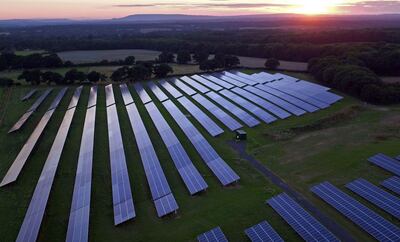Renewables are set to turbocharge an 8 per cent rise in investment in global energy this year to £1.96 trillion ($2.4tn), a report has shown.
The International Energy Agency expect more investors to lean towards clean energy amid the universal drive to seek alternatives to fossil fuels.
But the agency said such growth will be far from enough to redress all aspects of the energy crisis and will also fall short of establishing a more sustainable and secure future for billions of people around the world.
The race for greener energy options in recent years has not been evenly spread, with most of the spending taking place in advanced economies as well as China. High prices and energy security concerns in some markets have prompted higher investment in fossil fuel supplies, most notably in coal.
The fastest growth in energy investment is coming from the power sector — mainly in renewables and grids — and from energy efficiency, the agency’s World Energy Investment 2022 report showed.
“Our updated tracking, across all sectors, technologies and regions, suggests that world energy investment is set to rise over 8 per cent in 2022to reach a total of $2.4tn [£1.96tn], well above pre-Covid levels,” the report stated.
“Investment is increasing in all parts of the energy sector, but the main boost in recent years has come from the power sector — mainly in renewables and grids — and from increased spending on end-use efficiency.

“Investment in oil, gas, coal and low-carbon fuel supply is the only area that, in aggregate, remains below the levels seen prior to the pandemic in 2019. This is despite sky-high fuel prices that are generating an unprecedented windfall for suppliers: net income for the world’s oil and gas producers is set to double in 2022 to an unprecedented $4tn [£3.26tn].”
Asked by The National how governments can attract more investment in green energy, Tim Gould, chief energy economist at the IEA, said there were two main areas to address.
Touching on the rise in popularity in electric vehicles and solar energy, he said world leaders can break down the barriers to investment by putting in place the “policy and regulatory mechanisms that unlock the economic advantages of those technologies".
“These are competitive [forms of energy], these are the low-cost options for investment and it’s really a case of dealing with the non-market barriers that are preventing companies from investing and sometimes households from investing,” he said.
“That could be just by [introducing] changes to permitting regimes, it could be the way that governments bring new capacity into the electricity market, the confidence that investors have in the remuneration for those investments."
Mr Gould suggested that governments create a better environment for investment in clean energy by funding research and development into new and developing technology.
He said “even with today’s high fossil fuel prices” clean energy technology will “need a helping hand from governments to get them moving more quickly”.
“Areas like low emissions hydrogen, carbon-capture utilisation and storage, some of the emerging technologies that still need support on the research and development side," he said. "And there the involvement of governments is not to unblock but to really incentivise and there’s a different set of policy instruments that can be extraordinarily useful and important bringing those new technologies up to speed and upscale into energy systems around the world.”
The agency's executive director Fatih Birol said the “only lasting solution” to the energy and climate crises was increased investment in alternatives to fossil fuel.
“We cannot afford to ignore either today’s global energy crisis or the climate crisis but the good news is that we do not need to choose between them — we can tackle both at the same time,” he said.
“A massive surge in investment to accelerate clean energy transitions is the only lasting solution. This kind of investment is rising but we need a much faster increase to ease the pressure on consumers from high fossil fuel prices, make our energy systems more secure and get the world on track to reach our climate goals.”
The signing of the Paris Climate Agreement by leading world powers in 2015 led to a rise in clean energy investment of about 2 per cent annually in the following five years.
But since 2020, the pace of growth has increased by 12 per cent, driven by government fiscal support. Renewables, grids and storage now account for more than 80 per cent of total investment in the power sector.
The amount people are spending on renewable energy products, such as solar electricity panels and electric vehicles, is now growing at rates consistent with reaching global net-zero emissions targets by 2050.
The agency report said cost pressures stemming from supply chain issues and tight markets are having an adverse effect not only on fuel, but also on clean energy technology.
After years of gradual decline, the costs of solar panels and wind turbines are up by between 10 per cent and 20 per cent since 2020, the report said.





